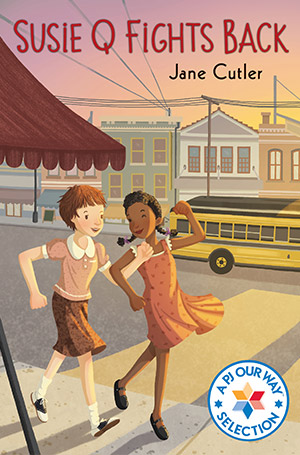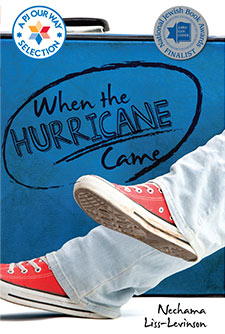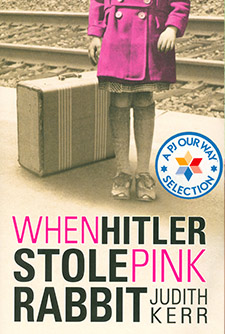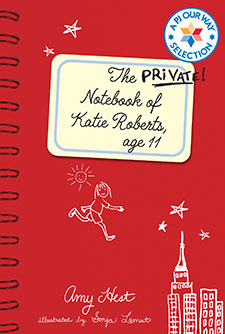Susie Q Fights Back
When Susan moves from New York to St. Louis, she discovers that her new friend, Loretta, can’t live in their building because she’s black. It’s so unfair, but it’s the law! Susan and her friends want things to change, but what can a few kids do?
Average Rating
( hint: Login to leave a review! )
56 Reviews
Leave Review
What the Book is About
Jewish Content & Values
Positive Role Models
Content Advisory
Talk it Over!
More for You
What the Book is About
When Susan Marcus moves from New York City to St. Louis for her father’s job, she leaves behind her best friend and worries about fitting in. She makes new friends, Loretta and Marlene, but discovers that Loretta and her mother, who are African-American, must live secretly in the basement because in the south, in 1943, the law says blacks and whites can’t live in the same building. And that’s not the only injustice she sees: Marlene’s grandmother is anti-Semitic, and the Chinese restaurant is vandalized because it’s wartime and people assume the owners are Japanese enemies. Outraged by the intolerance around them, Susan and her friends hatch a plan to take a stand for tolerance and friendship. Although discrimination and prejudice are key themes of this novel, the story itself is largely sweet and slightly old-fashioned in tone, in keeping with the period in which it’s set.
Jewish Content & Values
- Susan’s social activism is an example of tikkun olam (healing the world).
- Susan shows moral courage (ometz lev) in devising her plan to challenge racial inequality even though she might get in trouble.
Positive Role Models
Susan finds a way to bend the rules, but not break them, to make her stand against prejudice. Her action is part of the tradition of nonviolent protests in the civil rights movement.
Content Advisory
- Marlene’s grandmother makes a disparaging reference to Susan’s father being Jewish, and Susan’s soldier cousin is told to remove his dog tags in case the Germans capture and kill him because he is Jewish. Later, when Susan’s family goes to the Chinese restaurant, they see the window smashed and anti-Japanese graffiti painted on the windows and sidewalk. These episodes may be mildly disturbing for some sensitive readers.
Talk it Over!
When Marlene’s grandmother questions why Marlene’s mother is socializing with a Jew, Susan says it’s okay, that she and her mom are Jewish too. If you were in the room when someone was being mean about your religion or culture, what would you do?
More for You
Jews have a long history in the civil rights movement. In the early twentieth century, the chairman of the department store Sears Roebuck, Julius Rosenwald, gave millions of dollars to causes in support of Southern African-Americans, including building over 5,000 schools. In the 1960s, rabbis marched with demonstrators in Selma and Birmingham, Alabama, and around half of the young people who participated in the Mississippi Freedom Summer, the 1964 campaign to register African-American voters, were Jewish.
What the Book is About
What the Book is About
When Susan Marcus moves from New York City to St. Louis for her father’s job, she leaves behind her best friend and worries about fitting in. She makes new friends, Loretta and Marlene, but discovers that Loretta and her mother, who are African-American, must live secretly in the basement because in the south, in 1943, the law says blacks and whites can’t live in the same building. And that’s not the only injustice she sees: Marlene’s grandmother is anti-Semitic, and the Chinese restaurant is vandalized because it’s wartime and people assume the owners are Japanese enemies. Outraged by the intolerance around them, Susan and her friends hatch a plan to take a stand for tolerance and friendship. Although discrimination and prejudice are key themes of this novel, the story itself is largely sweet and slightly old-fashioned in tone, in keeping with the period in which it’s set.
Jewish Content & Values
Jewish Content & Values
- Susan’s social activism is an example of tikkun olam (healing the world).
- Susan shows moral courage (ometz lev) in devising her plan to challenge racial inequality even though she might get in trouble.
Positive Role Models
Positive Role Models
Susan finds a way to bend the rules, but not break them, to make her stand against prejudice. Her action is part of the tradition of nonviolent protests in the civil rights movement.
Content Advisory
Content Advisory
- Marlene’s grandmother makes a disparaging reference to Susan’s father being Jewish, and Susan’s soldier cousin is told to remove his dog tags in case the Germans capture and kill him because he is Jewish. Later, when Susan’s family goes to the Chinese restaurant, they see the window smashed and anti-Japanese graffiti painted on the windows and sidewalk. These episodes may be mildly disturbing for some sensitive readers.
Talk it Over!
Talk it Over!
When Marlene’s grandmother questions why Marlene’s mother is socializing with a Jew, Susan says it’s okay, that she and her mom are Jewish too. If you were in the room when someone was being mean about your religion or culture, what would you do?
More for You
More for You
Jews have a long history in the civil rights movement. In the early twentieth century, the chairman of the department store Sears Roebuck, Julius Rosenwald, gave millions of dollars to causes in support of Southern African-Americans, including building over 5,000 schools. In the 1960s, rabbis marched with demonstrators in Selma and Birmingham, Alabama, and around half of the young people who participated in the Mississippi Freedom Summer, the 1964 campaign to register African-American voters, were Jewish.




